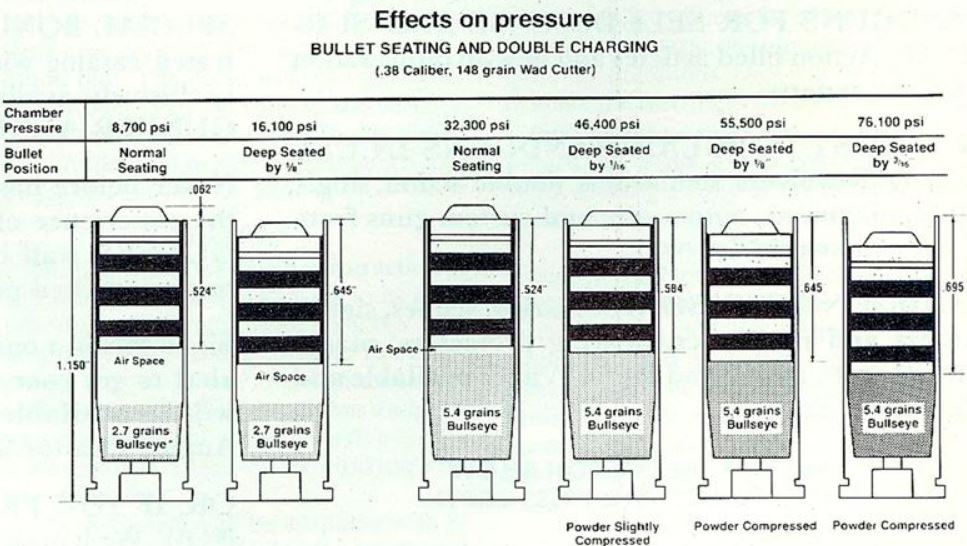Effects on pressure - Bullet Seating And Double Charging
American Handgunner, vol. 7, No. 32, Jan/Feb 1982, pages
8, 69
https://americanhandgunner.com/1982issues/HJF82.pdf
NO
SURPRISES WITH 2.7 GRAINS OF BULLSEYE
Dear Mr. Rakusan:
We at Hercules were dismayed to read the Handloading Section of your September/October, 1981, issue. Under the title, "How to Make Reloading Dangerous, or, The 2.7 Bullseye Surprise;' Dan Cotterman implied that light charges of Bullseye could misbehave, or explode, and magically blow up handguns. Since American Handgunner and Hercules share a common goal of shooter education and safety, we appreciate your offer to print our analysis of this problem.
In order to explain the blow-up of a Los Angeles police service revolver three years ago, Hercules analyzed thoroughly the use of 2.7 grains of Bullseye in the .38 Spl. behind the l48-grain wadcutter bullet. Our tests completely exonerated Bullseye and were included in an article by Bill Davis in the December, 1978, issue of American Rifleman. Your readers may obtain a free reprint by writing to: R. G. Guenter, Hercules Incorporated, Wilmington, DE 19899. The work is condensed below-.
Blown-up revolvers typically have a fractured cylinder, split lengthwise between the just- fired chamber and one or both of the adjacent chambers. Metallurgical examination of the grain structure of the steel surfaces of these fractures proved that the failure is from excess gas pressure of normal powder combustion, not from the' shock wave of a detonation. Since Hercules also produces detonating devices of many types, our metallurgists easily distinguish between the effects of combustion and detonation. As a double check, we also attempted to deliberately detonate a cartridge in a revolver. The primer was replaced by a military detonator containing 1.5 grains of extremely powerful high explosive, followed by 2.3 grains of Bullseye and a wadcutter bullet (3.8 grains of total energy). When we initiated the detonator, the cylinder remained intact and the chamber was barely swelled. This confirmed our thermo-chemical knowledge that there is not nearly enough energy in 2.7 grains of Bullseye to burst the cylinder of a good gun.
Up to this point, we had proven what does not occur, namely detonation. There simply is not enough energy in 2.7 grains of Bullseye to burst a cylinder, and metallurgy showed that the cylinder bursts from gas pressure; that is, from normal combustion of powder. But 2.7 grains of powder with a properly seated bullet produces only 8,700 psi, far below the proof pressure for .38 Spl., and the (estimated) 50,000 to 70,000 psi catastrophic failure level of the cylinder of light-frame to heavy-frame models. So, how can the cylinder burst under such low pressure?
Effects On Pressure -Bullet
Seating and Double Charging

The causes are rather straightforward:
A. Multiple (2,3,4) charges of 2.7grains raise gun pressures dramatically.
B. The above mistake is worsened (still higher pressure) if the bullet is positioned deeper than prescribed.
The drawing illustrates both of these dangerous errors. Study each load, from left to right, and observe how these two errors each increase the gas pressure in the chamber. In all situations, the powder is burning normally and reproducibly. Since all revolver powders should burn completely before the bullet base clears the cylinder, multiple charges generate too much gas pressure for the available volume behind the bullet, while seating the bullet deeper reduces the available volume, thereby raising the pressure (Handbook of Physics: PV = NRT).
Since no sensible reloader would intentionally use multiple charges nor seat his bullet deeper than prescribed, we searched and found ways to produce each of these errors, plus proof of their occurrence.
Multiple
Powder Charges
(1) We deliberately distracted our technician by having him restart his progressive reloader or by interrupting his handloading. He produced double charges and triple charges.
(2) One police department published the results of their use of a fired case to collect powder while emptying a progressive reloader. Such cases were "emptied," then thrown into the bin. One such case was found to have 13 grains of highly compressed powder in it just prior to reloading.
(3) A letter in American Rifleman (September, 1978) reported a gun blowup at a firing range. The unfired ammo had 2.7 grains each, except one which had 7 grains. The shooter recalled that his tool stuck once or twice; every handle pull or jiggle evidently dropped another charge.
Deeply Seated
Bullets
(1) Incorrect setting of the bullet positioner is one way to seat the bullet deeper than prescribed.
(2) Grease build-up at this station has been reported; it pushes the bullet deeper.
(3) Trying to insert a second bullet will have the same effect.
The 2.7-grain Bullseye charge in .38 Special behind the wadcutter bullet must be the dominant handgun reload in this country. Little wonder that Bullseye usually is present when a blow-up occurs. In our own tests of multiple charges and deeply-seated bullets, we also used pistol powders made by others and, expectedly, they gave similar high pressures. Also, blow-ups of handguns have been reported when powders other than Bullseye were in the cartridge.
We are firmly convinced that neither Bullseye nor other pistol powders magically misbehave in handguns. The current Reloader's Guide, a free publication by Hercules, devotes a full page to precautions to be taken to avoid multiple charges of powder and to avoid firing cartridges which have deeply seated bullets. We urge every handloader to follow these suggestions, to check his reloading equipment, to load carefully, and to continue enjoying the accuracy attainable with 2.7 grains of Bullseye.
Respectfully,
R. G. Guenter
Hercules Incorporated